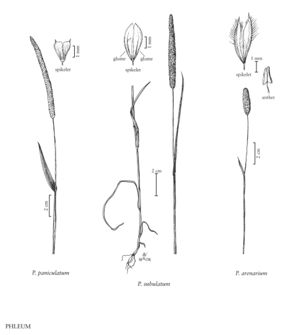familyPoaceae
subfamilyPoaceae subfam. Pooideae
tribePoaceae tribe Poeae
genusPhleum
speciesPhleum paniculatum
Difference between revisions of "Phleum paniculatum"
imported>Volume Importer |
imported>Volume Importer |
||
| Line 43: | Line 43: | ||
|publication year= | |publication year= | ||
|special status=Introduced | |special status=Introduced | ||
| − | |source xml=https://bitbucket.org/aafc-mbb/fna-data-curation/src/ | + | |source xml=https://bitbucket.org/aafc-mbb/fna-data-curation/src/200273ad09963decb8fc72550212de541d86569d/coarse_grained_fna_xml/V24/V24_949.xml |
|subfamily=Poaceae subfam. Pooideae | |subfamily=Poaceae subfam. Pooideae | ||
|tribe=Poaceae tribe Poeae | |tribe=Poaceae tribe Poeae | ||
Latest revision as of 17:26, 11 May 2021
Plants annual. Culms 5-30(55) cm, erect. Sheaths of the flag leaves not inflated; auricles not developed; ligules 5-7 mm, acute; blades to 19 cm long, 5-7 mm wide, flat or folded. Panicles 1-12 cm long, 3.5-7 mm wide, narrowly cylindrical, tapering somewhat distally. Glumes 1.5-2.5 mm, scabrous, inflated, keels sometimes slightly ciliate, margins ciliate distally, apices abruptly truncate, mucronate to awned, awns to 0.6 mm, lower glumes pilose on the margins; lemmas about 1/3 as long as the glumes, pubescent; anthers 0.3-0.5 mm. 2n = 28.
Discussion
Phleum paniculatum is native to dry habitats in southern and south-central Europe. In the Flora region, it is known only from old ballast dump records.
Selected References
None.
Lower Taxa
None.
